Susceptibility of Vegetative Cells and Endospores of Bacillus cereus to Rhamnolipid Biosurfactants and Their Potential Application in Dairy
Abstract
1. Introduction
2. Materials and Methods
2.1. Biosurfactant Stock Solution
2.2. B. cereus Strains
2.3. Fourier-Transform Infrared (FTIR) Spectroscopy
2.4. Determination of Minimal Inhibitory Concentration (MIC) and Minimal Bactericidal Concentration (MBC) of Vegetative Cells and Endospores
2.5. Time–Kill Assay
2.6. Endospore Germination Inhibition
2.7. Endospore Staining
2.8. Scanning Electron Microscopy (SEM) of B. cereus Endospores
2.9. Transmission Electron Microscopy (TEM) of B. cereus Endospores
2.10. Growth of Vegetative Cells and Endospores of B. cereus in Skim Milk
2.11. Statistics
3. Results and Discussion
3.1. Fourier-Transform Infrared (FTIR) Spectroscopy
3.2. Determination of Minimal Inhibitory Concentration (MIC) and Minimal Bactericidal Concentration (MBC)
3.3. Time–Kill Assay and Endospore Germination Inhibition
3.4. Electron Microscopy of B. cereus Endospores
3.5. Evaluation of Growth of Vegetative Cells and Endospores of B. cereus in Skim Milk
Author Contributions
Funding
Institutional Review Board Statement
Informed Consent Statement
Data Availability Statement
Acknowledgments
Conflicts of Interest
References
- WHO. WHO. WHO Estimates of the Global Burden of Foodborne Diseases: Executive Summary. In WHO Executive Summary; WHO: Geneva, Switzerland, 2015; p. 257. [Google Scholar]
- Ministério da Saúde. Informe sobre surtos notificados de doenças transmitidas por água e alimentos—Brasil, 2016-2019. Boletim Epidemiológico. Secretaria de Vigilância em Saúde, Volume 51, n° 32, Agosto 2020. Available online: https://www.gov.br/saude/pt-br/centrais-de-conteudo/publicacoes/boletins/epidemiologicos/edicoes/2020/boletim-epidemiologico-svs-32.pdf/view (accessed on 18 January 2022).
- Carroll, L.M.; Wiedmann, M.; Mukherjee, M.; Nicholas, D.C.; Mingle, L.A.; Dumas, N.B.; Cole, J.A.; Kovac, J. Characterization of emetic and diarrheal Bacillus cereus strains from a 2016 foodborne outbreak using whole-genome sequencing: Addressing the microbiological, epidemiological, and bioinformatic challenges. Front. Microbiol. 2019, 10, 114. [Google Scholar] [CrossRef] [PubMed]
- Thirkell, C.E.; Sloan-Gardner, T.S.; Kacmarek, M.C.; Polkinghorne, B. An outbreak of Bacillus cereus toxin-mediated emetic and diarrhoeal syndromes at a restaurant in Canberra, Australia 2018. Commun. Dis. Intell. 2019, 43, 1–9. [Google Scholar] [CrossRef] [PubMed]
- Dichtl, K.; Koeppel, M.B.; Wallner, C.P.; Marx, T.; Wagener, J.; Ney, L. Food poisoning: An underestimated cause of Boerhaave syndrome. Infection 2020, 48, 125–128. [Google Scholar] [CrossRef] [PubMed]
- Choi, W.; Kim, S.S. Outbreaks, germination, and inactivation of Bacillus cereus in food products: A review. J. Food Prot. 2020, 83, 1480–1487. [Google Scholar] [CrossRef]
- Ali, B.; Lee, L.H.; Laskar, N.; Shaikh, N.; Tahir, H.; Hsu, S.D.; Newby, R., Jr.; Valsechi-Diaz, J.; Chu, T. Modified Green Tea Polyphenols, EGCG-S and LTP, Inhibit Endospore in Three Bacillus spp. Adv. Microb. 2017, 07, 175–187. [Google Scholar] [CrossRef]
- Tallent, S.M.; Knolhoff, A. BAM: Quantitative Analysis for Cereulide in Food Products. 2020. Available online: https://www.fda.gov/food/laboratory-methods-food/bam-quantitative-analysis-cereulide-food-products (accessed on 8 January 2022).
- Huang, Q.; Zhang, Z.; Liu, Q.; Liu, F.; Liu, Y.; Zhang, J.; Wang, G. SpoVG is an important regulator of sporulation and affects biofilm formation by regulating Spo0A transcription in Bacillus cereus 0–9. BMC Microbiol. 2021, 21, 1–17. [Google Scholar] [CrossRef] [PubMed]
- Carocho, M.; Morales, P.; Ferreira, I.C.F.R. Natural food additives: Quo vadis? Trends Food Sci. Technol. 2015, 45, 284–295. [Google Scholar] [CrossRef]
- Gray, J.A.; Chandry, P.S.; Kaur, M.; Kocharunchitt, C.; Bowman, J.P.; Fox, E.M. Novel biocontrol methods for Listeria monocytogenes biofilms in food production facilities. Front. Microbiol. 2018, 9, 1–12. [Google Scholar] [CrossRef]
- Drakontis, C.E.; Amin, S. Biosurfactants: Formulations, properties, and applications. Curr. Opin. Colloid Interface Sci. 2020, 48, 77–90. [Google Scholar] [CrossRef]
- Mohanty, S.S.; Koul, Y.; Varjani, S.; Pandey, A.; Ngo, H.H.; Chang, J.S.; Wong, J.W.C.; Bui, X.T. A critical review on various feedstocks as sustainable substrates for biosurfactants production: A way towards cleaner production. Microb. Cell Factories 2021, 20, 120. [Google Scholar] [CrossRef]
- Mulligan, C.; Sharma, S.; Mudhoo, A.; Makhijani, K. Green Chemistry and Biosurfactant Research. In Biosurfactants; CRC Press: Boca Raton, FL, USA, 2014; pp. 1–30. [Google Scholar] [CrossRef]
- Silva, S.S.; Carvalho, J.W.P.; Aires, C.P.; Nitschke, M. Disruption of Staphylococcus aureus biofilms using rhamnolipid biosurfactants. J. Dairy Sci. 2017, 100, 7864–7873. [Google Scholar] [CrossRef] [PubMed]
- Clements, T.; Ndlovu, T.; Khan, S.; Khan, W. Biosurfactants produced by Serratia species: Classification, biosynthesis, production and application. Appl. Microbiol. Biotechnol. 2019, 103, 589–602. [Google Scholar] [CrossRef] [PubMed]
- Sabarinathan, D.; Vanaraj, S.; Sathiskumar, S.; Poorna Chandrika, S.; Sivarasan, G.; Arumugam, S.S.; Preethi, K.; Li, H.; Chen, Q. Characterization and application of rhamnolipid from Pseudomonas plecoglossicida BP03. Lett. Appl. Microbiol. 2021, 72, 251–262. [Google Scholar] [CrossRef]
- Nitschke, M.; Silva, S.S. Recent food applications of microbial surfactants. Crit. Rev. Food Sci. Nutr. 2018, 58, 631–638. [Google Scholar] [CrossRef]
- Bertuso, P.C.; Mayer, D.M.D.; Nitschke, M. Combining Celery Oleoresin, Limonene and Rhamnolipid as New Strategy to Control Endospore-Forming Bacillus cereus. Foods 2021, 10, 455. [Google Scholar] [CrossRef] [PubMed]
- Tauveron, G.; Slomianny, C.; Henry, C.; Faille, C. Variability among Bacillus cereus strains in spore surface properties and influence on their ability to contaminate food surface equipment. Int. J. Food Microbiol. 2006, 110, 254–262. [Google Scholar] [CrossRef] [PubMed]
- Okinaka, R.T.; Keim, P. The Phylogeny of Bacillus cereus sensu lato. Microbiol. Spectr. 2016, 4, 1–12. [Google Scholar] [CrossRef]
- Clinical and Laboratory Standards Institute, Methods for Dilution Antimicrobial Susceptibility Tests for Bacteria That Grow Aerobically, 9th ed.; Approved Standard; CLSI document M07-A9: Wayne, PA, USA, 2012; ISBN1 1-56238-783-9 [Print]. ISBN2 1-56238-784-7 [Electronic].
- Verma, P. Methods for determining bactericidal activity and antimicrobial interactions: Synergy testing, time-kill curves, and population analysis. In Antimicrobial Susceptibility Testing Protocols; Schwalbe, R., Steele-Moore, L., Goodwin, A.C., Eds.; Taylor & Francis: Boca Raton, FL, USA, 2007; pp. 275–299. [Google Scholar]
- Miles, A.A.; Misra, S.S.; Irwin, J.O. The estimation of the bactericidal power of the blood. Epidemiol. Infect. 1938, 38, 732–749. [Google Scholar] [CrossRef]
- Hamouda, T.; Shih, A.Y.; Baker, J.R. A rapid staining technique for the detection of the initiation of germination of bacterial spores. Lett. Appl. Microbiol. 2002, 34, 86–90. [Google Scholar] [CrossRef]
- Murtey, M.; Ramasamy, P. Sample preparations for scanning electron microscopy—Life sciences. In Modern Electron Microscopy in Physical and Life Sciences; Janecek, M., Kral, R., Eds.; IntechOpen: London, UK, 2016. [Google Scholar]
- Rabinovitch, L.; Oliveira, E.J. Coletânea de procedimentos técnicos e metodologias empregadas para o estudo de Bacillus e gêneros esporulados aeróbios correlatos, 1st ed.; Montenegro Comunicação: Rio de Janeiro, Brazil, 2015; 160p, ISBN 978-85-67506-04-3. [Google Scholar]
- Huang, X.; Lu, Z.; Bie, X.; Lü, F.X.; Zhao, H.; Yang, S. Optimization of inactivation of endospores of Bacillus cereus by antimicrobial lipopeptides from Bacillus subtilis fmbj strains using a response surface method. App. Microbiol. Biotechnol. 2007, 74, 454–461. [Google Scholar] [CrossRef]
- Sun, L.; Atkinson, K.; Zhu, M.; D’Amico, D.J. Antimicrobial effects of a bioactive glycolipid on spore-forming spoilage bacteria in milk. J. Dairy Sci. 2021, 104, 4002–4011. [Google Scholar] [CrossRef] [PubMed]
- Nitschke, M.; Marangon, C.A. Microbial surfactants in nanotechnology: Recent trends and applications. Crit. Rev. Biotechnol. 2022, 42, 294–310. [Google Scholar] [CrossRef] [PubMed]
- Wittgens, A.; Rosenau, F. Heterologous Rhamnolipid Biosynthesis: Advantages, Challenges, and the Opportunity to Produce Tailor-Made Rhamnolipids. Front. Bioeng. Biotechnol. 2020, 8, 594010. [Google Scholar] [CrossRef] [PubMed]
- Bi, H.Y.; Li, Y. Preparation of rhamnolipid-layered double hydroxide nanocomposite for removing p-cresol from water. Adsorp. Sci. Technol. 2018, 36, 233–246. [Google Scholar] [CrossRef]
- Pornsunthorntawee, O.; Wongpanit, P.; Chavadej, S.; Abe, M.; Rujiravanit, R. Structural and physicochemical characterization of crude biosurfactant produced by Pseudomonas aeruginosa SP4 isolated from petroleum-contaminated soil. Bioresour. Technol. 2008, 99, 1589–1595. [Google Scholar] [CrossRef]
- Cho, W.; Chung, M.S. Bacillus spores: A review of their properties and inactivation processing technologies. Food Sci. Biotechnol. 2020, 29, 1447–1461. [Google Scholar] [CrossRef] [PubMed]
- Ávila, M.; Gómez-Torres, N.; Hernández, M.; Garde, S. Inhibitory activity of reuterin, nisin, lysozyme and nitrite against vegetative cells and spores of dairy-related Clostridium species. Int. J. Food Microbiol. 2014, 172, 70–75. [Google Scholar] [CrossRef] [PubMed]
- Hofstetter, S.; Gebhardt, D.; Ho, L.; Gänzle, M.; McMullen, L.M. Effects of nisin and reutericyclin on resistance of endospores of Clostridium spp. to heat and high pressure. Food Microbiol. 2013, 34, 46–51. [Google Scholar] [CrossRef]
- Seligy, V.L.; Rancourt, J.M. Antibiotic MIC/MBC analysis of Bacillus-based commercial insecticides: Use of bioreduction and DNA-based assays. J. Ind. Microbiol. Biotechnol. 1999, 22, 565–574. [Google Scholar] [CrossRef]
- Shu, Q.; Niu, Y.; Zhao, W.; Chen, Q. Antibacterial activity and mannosylerythritol lipids against vegetative cells and spores of Bacillus cereus. Food Control. 2019, 106, 106711. [Google Scholar] [CrossRef]
- Broussolle, V.; Gauillard, F.; Nguyen-The, C.; Carlin, F. Diversity of spore germination in response to inosine and L-alanine and its interaction with NaCl and pH in the Bacillus cereus group. J. Appl. Microbiol. 2008, 105, 1081–1090. [Google Scholar] [CrossRef] [PubMed]
- Shaheen, R. Bacillus cereus Spores and Cereulide in Food-Borne Illness Department of Applied Chemistry and Microbiology. Ph.D. Thesis, University of Helsinki, Helsinki, Finland, 2009. [Google Scholar]
- Setlow, P. Germination of spores of Bacillus species: What we know and do not know. J. Bacteriol. 2014, 196, 1297–1305. [Google Scholar] [CrossRef] [PubMed]
- Kulikovskiĭ, A.V. Structural changes in spores under high temperature exposure. Zh. Mikrobiol. Epidemiol. Immunobiol. 1979, 6, 65–67. [Google Scholar]
- Ryang, J.H.; Kim, N.H.; Lee, B.S.; Kim, C.T.; Rhee, M.S. Destruction of Bacillus cereus spores in a thick soy bean paste (doenjang) by continuous ohmic heating with five sequential electrodes. Lett. Appl. Microbiol. 2016, 63, 66–73. [Google Scholar] [CrossRef]
- Liao, X.; Bai, Y.; Muhammad, A.I.; Liu, D.; Hu, Y.; Ding, T. The application of plasma-Activated water combined with mild heat for the decontamination of Bacillus cereus spores in rice (Oryza sativa L. ssp. japonica). J. Phys. D 2020, 53, 064003. [Google Scholar] [CrossRef]
- Ferreira, J.F.; Vieira, E.A.; Nitschke, M. The antibacterial activity of rhamnolipid biosurfactant is pH dependent. Food Res. Int. 2019, 116, 737–744. [Google Scholar] [CrossRef]
- Ortiz, A.; Teruel, J.A.; Espuny, M.J.; Marqués, A.; Manresa, Á.; Aranda, F.J. Effects of dirhamnolipid on the structural properties of phosphatidylcholine membranes. Int. J. Pharm. 2006, 325, 99–107. [Google Scholar] [CrossRef]
- Sotirova, A.V.; Spasova, D.I.; Galabova, D.N.; Karpenko, E.; Shulga, A. Rhamnolipid—Biosurfactant Permeabilizing Effects on Gram-Positive and Gram-Negative Bacterial Strains. Curr. Microbiol. 2008, 56, 639–644. [Google Scholar] [CrossRef]
- Piktel, E.; Pogoda, K.; Roman, M.; Niemirowicz, K.; Tokajuk, G.; Wróblewska, M.; Szynaka, B.; Kwiatek, W.M.; Savage, P.B.; Buck, R. Sporicidal activity of ceragenin CSA-13 against Bacillus subtilis. Sci. Rep. 2017, 7, 44452. [Google Scholar] [CrossRef]
- van Melis, C.C.J.; Almeida, C.B.; Kort, R.; Groot, M.N.N.; Abee, T. Germination inhibition of Bacillus cereus spores: Impact of the lipophilic character of inhibiting compounds. Int. J. Food Microbiol. 2012, 160, 124–130. [Google Scholar] [CrossRef]
- Cho, W.; Cheigh, C.I.; Hwang, H.J.; Chung, M.S. Sporicidal activities of various surfactant components against Bacillus subtilis spores. J. Food Prot. 2015, 78, 1221–1225. [Google Scholar] [CrossRef] [PubMed]
- Black, E.P.; Huppertz, T.; Fitzgerald, G.F.; Kelly, A.L. Baroprotection of vegetative bacteria by milk constituents: A study of Listeria innocua. Int. Dairy, J. 2007, 17, 104–110. [Google Scholar] [CrossRef]
- Gera, N.; Doores, S. Kinetics and Mechanism of Bacterial Inactivation by Ultrasound Waves and Sonoprotective Effect of Milk Components. J. Food Sci. 2011, 76, 111–119. [Google Scholar] [CrossRef]
- Rodrigues, A.I.; Gudiña, E.J.; Teixeira, J.A.; Rodrigues, L.R. Sodium chloride effect on the aggregation behaviour of rhamnolipids and their antifungal activity. Sci. Rep. 2017, 7, 12907. [Google Scholar] [CrossRef]
- Farniya, F.; Jamalli, A.; Dadgar, T. Physicochemical surface characteristics in different pathogenic bacteria. Cogent Biol. 2019, 5, 1638572. [Google Scholar] [CrossRef]
- Food and Drug Administration. Bacillus cereus and other Bacillus species. In Bad Bug Book Handbook of Foodborne Pathogenic Microorganisms and Natural Toxins; CreateSpace Independent Publishing Platform: Scotts Valley, CA, USA, 2012; pp. 92–95. [Google Scholar]
- Valero, M.; Fernández, P.S.; Salmerón, M.C. Influence of pH and temperature on growth of Bacillus cereus in vegetable substrates. Int. J. Food Microbiol. 2003, 82, 71–79. [Google Scholar] [CrossRef]
- Ubong, A.; New, C.Y.; Chai, L.C.; Nur Fatihah, A.; Nur Hasria, K.; Nishibuchi, M.; Son, R. Impact of temperature on Bacillus cereus spore germination in ultra-high temperature chocolate milk. Food Res. 2019, 3, 808–813. [Google Scholar] [CrossRef]
- Martinez, R.C.R.; Alvarenga, V.O.; Thomazini, M.; Fávaro-Trindade, C.S.; de Souza Sant’Ana, A. Assessment of the inhibitory effect of free and encapsulated commercial nisin (Nisaplin®), tested alone and in combination, on Listeria monocytogenes and Bacillus cereus in refrigerated milk. LWT-Food Sci. Technol. 2016, 68, 67–75. [Google Scholar] [CrossRef]
- Shu, Q.; Wei, T.; Liu, X.; Liu, S.; Chen, Q. The dough-strengthening and spore-sterilizing effects of mannosylerythritol lipid-A in frozen dough and its application in bread making. Food Chem. 2021, 369, 131011. [Google Scholar] [CrossRef]
- Raza, Z.A.; Khalid, Z.M.; Khan, M.S.; Banat, I.M.; Rehman, A.; Naeem, A.; Saddique, M.T. Surface properties and sub-surface aggregate assimilation of rhamnolipid surfactants in different aqueous systems. Biotechnol. Lett. 2010, 32, 811–816. [Google Scholar] [CrossRef]
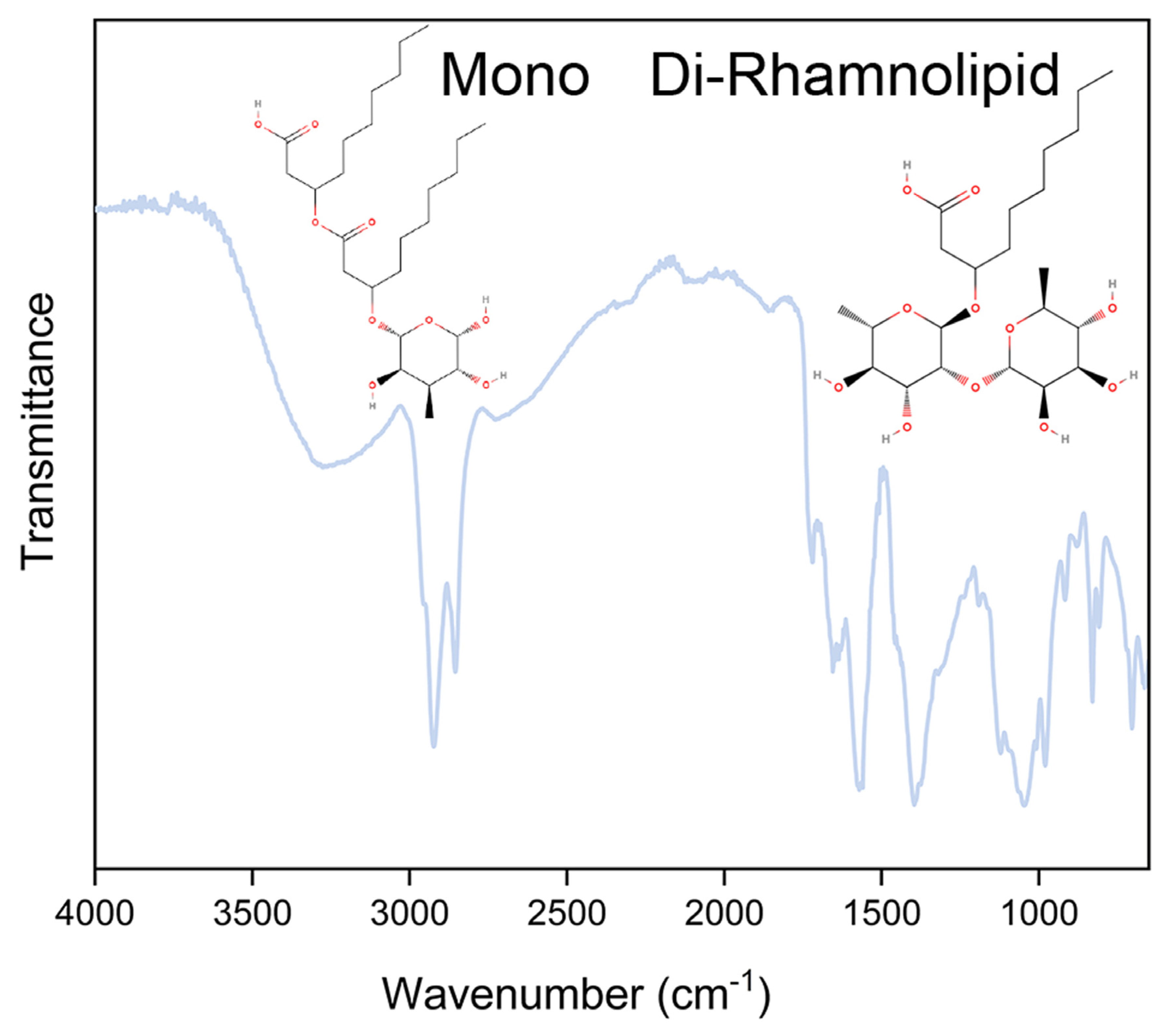
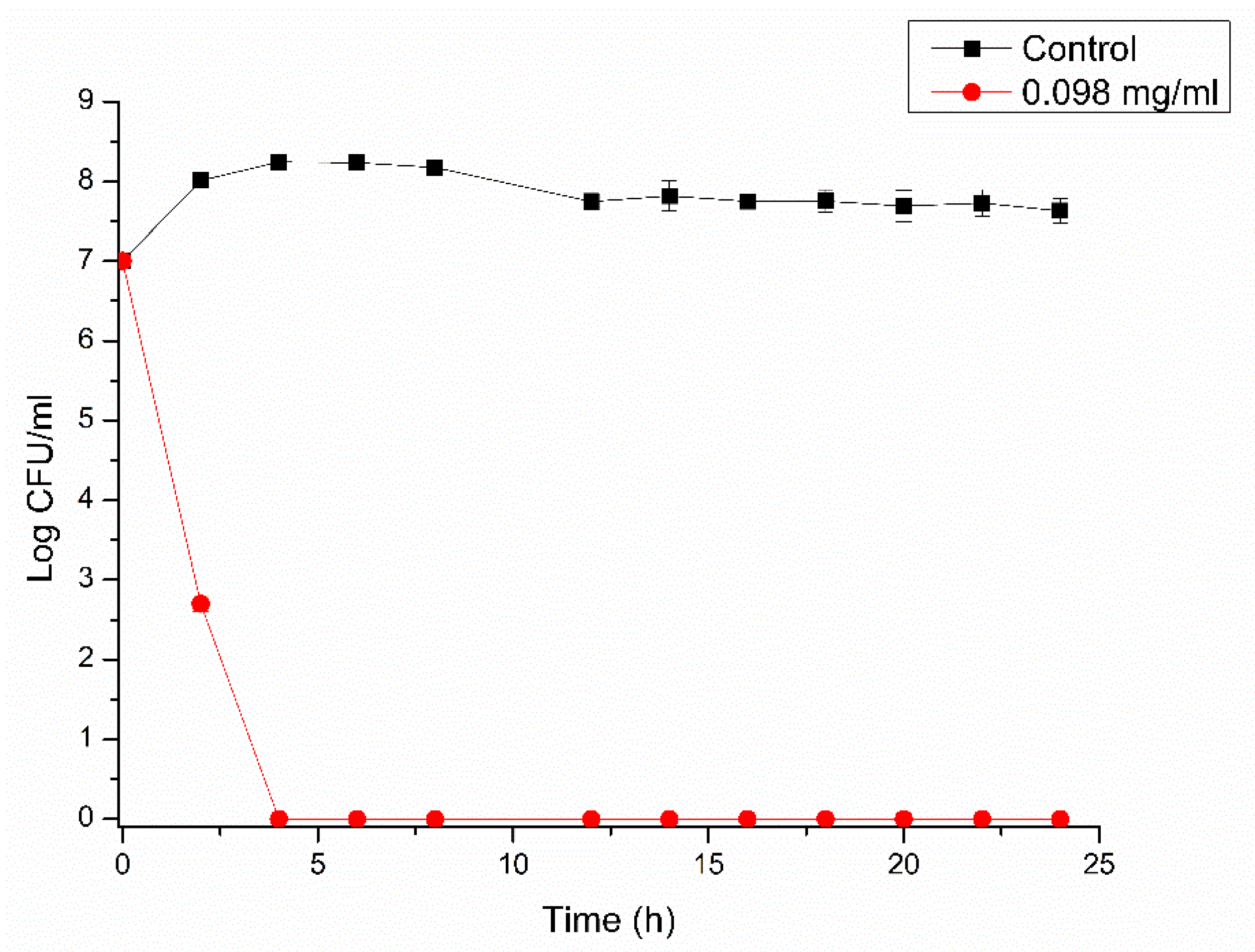
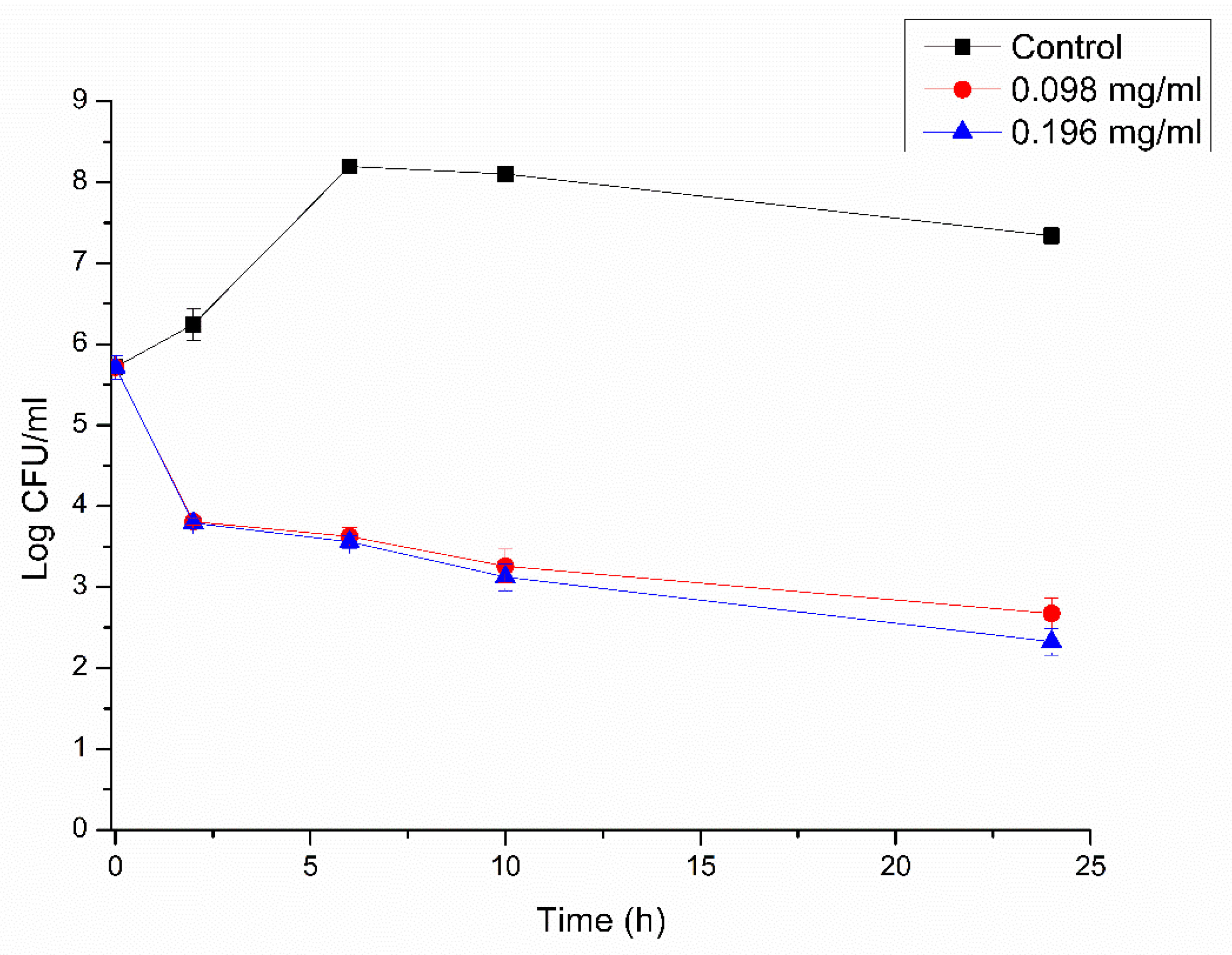
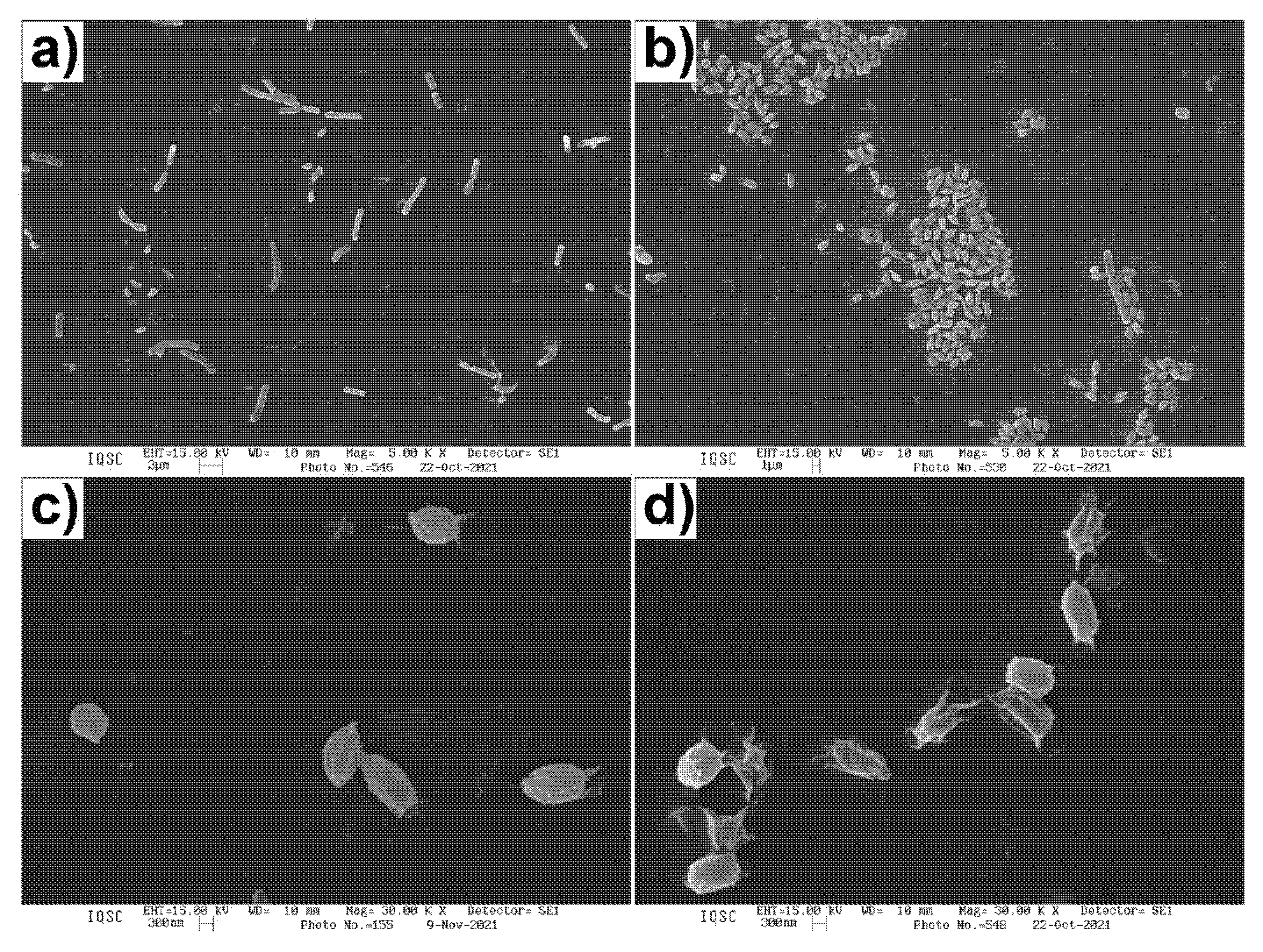
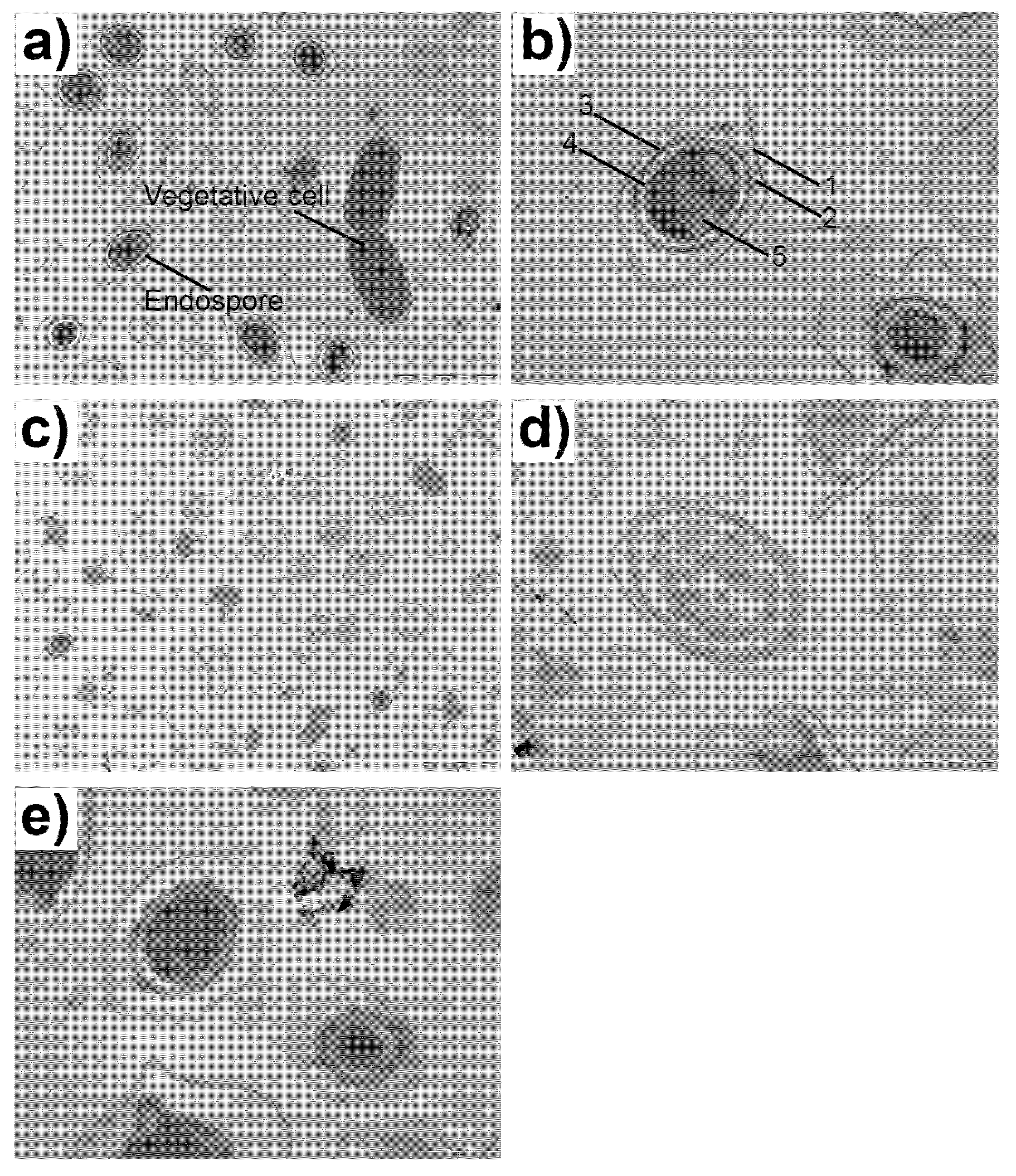


| Code | Collection | Isolated From |
|---|---|---|
| 10876 | ATCC | Contaminated flask |
| 11778 | ATCC | Not informed |
| 33018 | ATCC | Infant milk formula |
| 33019 | ATCC | Infant milk formula |
| 0426 | CCGB/FIOCRUZ | Chicken pot pie |
| 0477 | CCGB/FIOCRUZ | Milk |
| 0524 | CCGB/FIOCRUZ | Raw beef |
| 0534 | CCGB/FIOCRUZ | Skim powdered milk |
| 0547 | CCGB/FIOCRUZ | Cooked corn meal |
| 1217 | CCGB/FIOCRUZ | Powdered nutmeg |
| 1223 | CCGB/FIOCRUZ | Oregano |
| 1224 | CCGB/FIOCRUZ | Raw Yuca flour |
| 1517 | CCGB/FIOCRUZ | Coffee |
| 1734 | CCGB/FIOCRUZ | Powdered milk |
| Vegetative Cells (mg/mL) | Endospores (mg/mL) | |||
|---|---|---|---|---|
| Strain Code | MIC | MBC | MIC | MBC |
| 10876 | 0.098 | 6.25 | 0.098 | 0.78 |
| 11778 | 0.78 | >25 | 0.098 | 1.56 |
| 33018 | 0.098 | >25 | 0.098 | >25 |
| 33019 | 0.098 | 0.098 | 0.098 | 3.13 |
| 0426 | 0.098 | 0.098 | 0.098 | >25 |
| 0477 | 0.098 | 0.098 | 0.098 | 6.25 |
| 0524 | 0.098 | >25 | 0.098 | 6.25 |
| 0534 | 0.098 | 0.098 | 0.098 | 1.56 |
| 0547 | 0.098 | 0.098 | 0.098 | 3.13 |
| 1217 | 0.098 | 6.25 | 0.098 | 6.25 |
| 1223 | 0.098 | 6.25 | 0.098 | 1.56 |
| 1224 | 0.098 | 25 | 0.098 | 3.13 |
| 1517 | 0.098 | 0.098 | 0.098 | 25 |
| 1734 | 0.098 | 12.5 | ≥0.049 | 6.25 |
Publisher’s Note: MDPI stays neutral with regard to jurisdictional claims in published maps and institutional affiliations. |
© 2022 by the authors. Licensee MDPI, Basel, Switzerland. This article is an open access article distributed under the terms and conditions of the Creative Commons Attribution (CC BY) license (https://creativecommons.org/licenses/by/4.0/).
Share and Cite
Bertuso, P.d.C.; Marangon, C.A.; Nitschke, M. Susceptibility of Vegetative Cells and Endospores of Bacillus cereus to Rhamnolipid Biosurfactants and Their Potential Application in Dairy. Microorganisms 2022, 10, 1860. https://doi.org/10.3390/microorganisms10091860
Bertuso PdC, Marangon CA, Nitschke M. Susceptibility of Vegetative Cells and Endospores of Bacillus cereus to Rhamnolipid Biosurfactants and Their Potential Application in Dairy. Microorganisms. 2022; 10(9):1860. https://doi.org/10.3390/microorganisms10091860
Chicago/Turabian StyleBertuso, Paula de Camargo, Crisiane Aparecida Marangon, and Marcia Nitschke. 2022. "Susceptibility of Vegetative Cells and Endospores of Bacillus cereus to Rhamnolipid Biosurfactants and Their Potential Application in Dairy" Microorganisms 10, no. 9: 1860. https://doi.org/10.3390/microorganisms10091860
APA StyleBertuso, P. d. C., Marangon, C. A., & Nitschke, M. (2022). Susceptibility of Vegetative Cells and Endospores of Bacillus cereus to Rhamnolipid Biosurfactants and Their Potential Application in Dairy. Microorganisms, 10(9), 1860. https://doi.org/10.3390/microorganisms10091860








